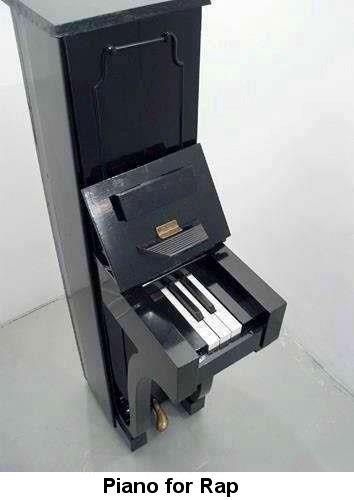Sight Reading in Different Keys
How to Handle the Accidentals

Rap piano... (Source: IMGR)
If you try to find some introductory stuff on sight-reading, most of it’s going to be written in C major. That’s great, but in real life, most songs are more complicated. (Unless you’re using a “rap piano”...)
Let’s look at some melodies in different keys.
The following melody is in G major. The first thing you should do is decide the position you’ll play it in. The decision was not made for you. Now you’re on your own.
How to make this decision?
Look at the lowest note in the example, and the highest note in the example.
Sight-Reading Example

Highest and Lowest Notes
The highest note, C, can be played in several places, all over the guitar fretboard. On the basis of the highest note, we may have no preference for what fret position to use in reading this example.
The first and lowest note, G below the staff, can only be played on the third fret of the sixth string. There is no other place on the guitar to play that note. We need to choose a position where that note is accessible, probably I or III. Since we have experience with position I, we’ll likely choose that, although it’s important to eventually learn to read music in any position.
What if the high note is very high and the low note is very low, so you need to play the music in multiple positions? Well, you can. It’s just hard, that’s all.
What Key Is It In?
Now Let’s determine the key. Look at the content of the notes and figure out what major scale those notes belong to.
This example has one F♯ in the key signature, so it looks like a G major, right? Let’s play a G major scale in the open position, from the lowest note used (G at fret III of string 6) to the highest note (C at fret I of string 2). This task is for you to figure out. What are the notes in a G major scale? How can you play them on the guitar? If you’re stuck, be sure to review your major scales and the notes on the guitar in the first position before you resort to Googling it.
Now, play the example. Say the name of each note on the staff. Find those notes on the fretboard. They must fall within the G major scale you just played.
This process can be slow and painful, but it is constructive. You need patience to learn the skill of sight-reading. There’s no way around that. But once you’ve acquired this skill, the reward is much greater than the investment.
Key Task
- Look at any other piece of music. See if you can determine the key, the highest note and the lowest note—and decide the best place to play it on the guitar.
 As the creator of Hub Guitar, Grey has compiled hundreds of guitar lessons, written several books, and filmed hundreds of video lessons. He teaches private lessons in his Boston studio, as well as via video chat through TakeLessons.
As the creator of Hub Guitar, Grey has compiled hundreds of guitar lessons, written several books, and filmed hundreds of video lessons. He teaches private lessons in his Boston studio, as well as via video chat through TakeLessons.